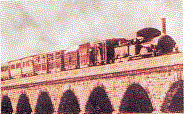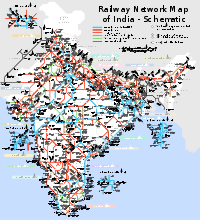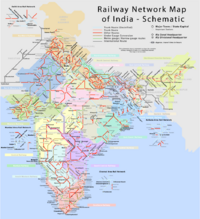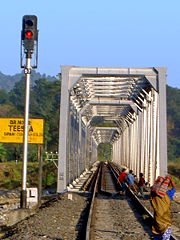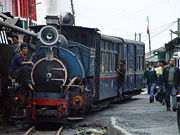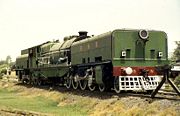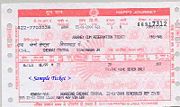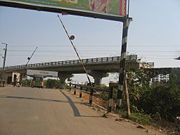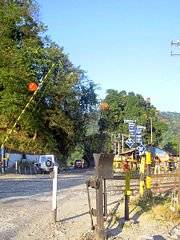7.5: War in India: Indian Rebellion of 1857
- Page ID
- 85859
Indian Railways (Hindi भारतीय रेल), abbreviated as IR, refers to a Department of the Government of India, under the Ministry of Railways, tasked with operating the rail network in India. A cabinet rank Railways Minister heads the Ministry, while the Railway Board manages the Department. Although a government agency, Indian Railways, of late, has been trying to adopt a corporate management style.
Indian Railways, a state monopoly on India’s rail transport, constitutes one of the largest and busiest rail networks in the world, transporting six billion passengers a year. The railways traverse the length and breadth of the country. IR is the world’s second largest commercial or utility employer, with more than 1.36 million employees.
The British first introduced railways to India in 1853. By 1947, the year of India’s independence, forty-two rail systems crossed the country. In 1951 the government nationalized the system as one unit, becoming one of the largest networks in the world. Indian Railways operates both long distance and suburban rail systems. Although Britain established the Indian railways in the 1850s as a way of exploiting Indian natural resources to fuel the Industrial Revolution in Great Britain, the railways have played a key role in the modernization and democratization of India since independence in 1947.
History
The British first put a plan for a rail system in India forward first in 1832, but a decade passed without action. In 1844, the Governor-General of India Lord Hardinge allowed private entrepreneurs to set up a rail system in India, creating two new railway companies; they asked the East India Company to assist them. Interest from investors in the UK led to the rapid creation of a rail system over the next few years. The first train in India became operational on 1851-12-22, used for hauling construction material in Roorkee. A year and a half later, on 1853-04-16, the first passenger train service began between Bori Bunder, Bombay and Thana. Three locomotives, Sahib, Sindh and Sultan covering the distance of 34 km (21 miles), giving birth of railways in India.
The British government encouraged new railway companies backed by private investors under a scheme that would guarantee an annual return of five percent during the initial years of operation. Once established, the company would be transferred to the government, with the original company retaining operational control. The route mileage of this network totaled about 14,500 km (9,000 miles) by 1880, mostly radiating inward from the three major port cities of Bombay, Madras and Calcutta. By 1895, India had started building its own locomotives, and in 1896 sent engineers and locomotives to help build the Uganda Railway.
Soon various independent kingdoms built their own rail systems and the network spread to the regions that became the modern-day states of Assam, Rajasthan and Andhra Pradesh. A Railway Board constituted in 1901, but the Viceroy, Lord Curzon retained decision-making power. The Railway Board operated under aegis of the Department of Commerce and Industry and had three members: a government railway official serving as chairman, a railway manager from England and an agent of one of the company railways. For the first time in its history, the railways began to make a tidy profit. In 1907, the government took over almost all the rail companies.
The following year, the first electric locomotive appeared. With the arrival of the First World War, the railways served the needs of the British outside India. By the end of the First World War, the railways had suffered immensely and falling into a poor state. The government took over the management of the Railways and removed the link between the financing of the Railways and other governmental revenues in 1920, a practice that continues to date with a separate railway budget.
The Second World War severely crippled the railways as the British diverted trains to the Middle East, and converted the railway workshops into munitions workshops. At the time of independence in 1947, a large portion of the railways passed to the then newly-formed Pakistan. A total of 42 separate railway systems, including 32 lines owned by the former Indian princely states, amalgamated as a single unit, christened as the Indian Railways.
The newly-seated India government abandoned the existing rail networks in favor of zones in 1951 and a total of six zones came into being in 1952. As the economy of India improved, almost all railway production units indigenized. By 1985, steam locomotives phased out in favor of diesel and electric locomotives. The entire railway reservation system was streamlined with computerization in 1995.
In the twenty-first century Indian Railways constitutes one of the largest and busiest rail networks in the world, transporting transporting six billion passengers a year.[4] IR has 114,500 kilometers (71,147 mi) of total track over a route of 65,000 kilometers (40,389 mi) and 7,500 stations.[3]The railways traverse the length and breadth of the country and carry over 30 million passengers and 2.8 million tons of freight daily.[3] It is the world’s second largest commercial or utility employer, with more than 1.36 million employees.[3] As for rolling stock, IR owns over 240,000 (freight) wagons, 60,000 coaches and 9,000 locomotives.[3]
Railway zones
For administrative purposes, Indian Railways divides into sixteen zones.
| No. | Name | Abbr. | Headquarters | Date established |
|---|---|---|---|---|
| 1. | Northern Railway | NR | Delhi | April 14, 1952 |
| 2. | North Eastern Railway | NER | Gorakhpur | 1952 |
| 3. | Northeast Frontier Railway | NFR | Maligaon(Guwahati) | 1958 |
| 4. | Eastern Railway | ER | Kolkata | April, 1952 |
| 5. | South Eastern Railway | SER | Kolkata | 1955, |
| 6. | South Central Railway | SCR | Secunderabad | October 2, 1966 |
| 7. | Southern Railway | SR | Chennai | April 14, 1951 |
| 8. | Central Railway | CR | Mumbai | November 5, 1951 |
| 9. | Western Railway | WR | Mumbai | November 5, 1951 |
| 10. | South Western Railway | SWR | Hubli | April 1, 2003 |
| 11. | North Western Railway | NWR | Jaipur | October 1, 2002 |
| 12. | West Central Railway | WCR | Jabalpur | April 1, 2003 |
| 13. | North Central Railway | NCR | Allahabad | April 1, 2003 |
| 14. | South East Central Railway | SECR | Bilaspur, CG | April 1, 2003 |
| 15. | East Coast Railway | ECoR | Bhubaneswar | April 1, 2003 |
| 16. | East Central Railway | ECR | Hajipur | October 1, 2002 |
| 17. | Konkan Railway† | KR | Navi Mumbai | January 26, 1998 |
†Konkan Railway (KR) operates as a separately incorporated railway, with its headquarters at Belapur CBD (Navi Mumbai), operating under the control of the Railway Ministry and the Railway Board.
Indian Railways owns and operates the Calcutta Metro, but not a part of any of the zones. Administratively, the railway has the status of a zonal railway. A certain number of divisions make up each zonal railway, each having a divisional headquarters and a total of sixty-seven divisions.
| Zonal Railway | Divisions |
|---|---|
| Northern Railway | Delhi, Ambala, Firozpur, Lucknow, Moradabad |
| North Eastern Railway | Izzatnagar, Lucknow, Varanasi |
| Northeast Frontier Railway | Alipurduar, Katihar, Lumding, Rangia, Tinsukia |
| Eastern Railway | Howrah, Sealdah, Asansol, Malda |
| South Eastern Railway | Adra, Chakradharpur, Kharagpur, Ranchi |
| South Central Railway | Secunderabad, Hyderabad, Guntakal, Guntur, Nanded, Vijayawada |
| Southern Railway | Chennai, Madurai, Palghat, Tiruchchirapalli, Trivandrum, Salem |
| Central Railway | Mumbai, Bhusawal, Pune, Solapur, Nagpur |
| Western Railway | Mumbai Central, Baroda, Ratlam, Ahmedabad, Rajkot, Bhavnagar |
| South Western Railway | Hubli, Bangalore, Mysore |
| North Western Railway | Jaipur, Ajmer, Bikaner, Jodhpur |
| West Central Railway | Jabalpur, Bhopal, Kota |
| North Central Railway | Allahabad, Agra, Jhansi |
| South East Central Railway | Bilaspur, Raipur, Nagpur |
| East Coast Railway | Khurda Road, Sambalpur, Visakhapatnam |
| East Central Railway | Danapur, Dhanbad, Mughalsarai, Samastipur, Sonpur |
Passenger services
Indian Railways operates 8,702 passenger trains and transports 15 million daily across 25 states and three union territories (Delhi, Puducherry (formerly Pondicherry) and Chandigarh). Sikkim, Arunachal Pradesh and Meghalaya are the only states not connected.
The passenger division rates as the most preferred form of long distance transport in most of the country.
A standard passenger train consists of 18 coaches, but some popular trains can have up to 24 coaches. Coaches have been designed to accommodate between 18 to 72 passengers, but may actually accommodate many more during the holiday seasons and on busy routes. The railways use vestibule coaches, with some of those dummied on some trains for operational reasons. Freight trains use a large variety of wagons.
Each coach has different accommodation class; the most popular being the sleeper class, with typically up to nine of those type coaches coupled. A standard train may have between three and five air-conditioned coaches. Online passenger ticketing, introduced in 2004, may top 100,000 per day by 2008, while ATMs in many stations will be equipped to dispense long-distance tickets by the end of 2007. The management has slated ATMs for installation on board select trains as well.
Production Services
The Indian Railways manufactures a lot of its rolling stock and heavy engineering components, largely for economic reasons, as important rail technology comes at a high price. The general state of the national engineering industry as matured over the past century and a half.
The ministry directly manages Production Units, the manufacturing plants of the Indian Railways. The General Managers of the PUs report to the Railway Board. The Production Units are:
- Central Organization For Railway Electrification, Allahabad
- Chittaranjan Locomotive Works, Chittaranjan
- Diesel Locomotive Works, Varanasi
- Diesel Locomotive Works, Ponmalaipatty, Tiruchirapalli
- Diesel-Loco Modernisation Works, Patiala
- Integral Coach Factory, Chennai
- Rail Coach Factory, Kapurthala
- Rail Wheel Factory, Bangalore
- Rail Spring Karkhana, Gwalior
- Bharat Earth Movers Limited, Bangalore
BEML, although independent of the railways, manufactures coaches for IR, Metro coaches for DMRC, and cars for Bangalore Metro.
Suburban rail
Many cities have their own dedicated suburban networks to cater to commuters. Currently, suburban networks operate in Mumbai (Bombay), Chennai (Madras), Kolkata (Calcutta), Delhi, Hyderabad and Pune. Hyderabad, and Pune lack dedicated suburban tracks but share the tracks with long distance trains. New Delhi, Chennai and Kolkata have their own metro networks, namely the New Delhi Metro, the Chennai MRTS- Mass Rapid Transport System, same as other local EMU suburban service as in Mumbai and Kolkata etc., but with dedicated tracks mostly laid on a flyover and the Kolkata Metro, respectively.
Usually electric multiple units Suburban trains handle commuter traffic. They usually have nine coaches or sometimes twelve to handle rush hour traffic (Hyderabad MMTS; abbreviation for Multi Modal Transport System has mostly six coach train with a single nine coach one). One unit of an EMU train consists of one power car and two general coaches. Thus three units having one power car at each end and one at the middle comprise a nine coach EMU. The rakes in Mumbai run on direct current, while those elsewhere use alternating current ([1]). A standard coach accommodates ninety six seated passengers, but the actual number of passengers can easily double or triple with standees during rush hour. The Kolkata metro has the administrative status of a zonal railway, though in another class from the seventeen railway zones.
The Suburban trains in Mumbai handle more rush then any other suburban network in India. The network has three lines viz, western, central and harbour. Considered the lifeline on Mumbaia Central Lines, the trains start from Chhatrapati Shivaji Terminus (CST) (Formerly Victoria Terminus or VT), running for more than 100 km till Kasara and Western Line. Starting from Churchgate, they run again for more than 100 km till Dahanu Road. Combined, that makes for the longest suburban rail in the world, as well as the busiest suburban network in the world, carrying more than five million passengers each day. On July 11, 2006 terrorists set off six bombs on those trains, targeting the general public.
Freight
The Darjeeling Himalayan Railway is a World Heritage Site, and one of the few places where steam engines are still in operation in India.
IR carries a huge variety of goods ranging from mineral ores, fertilizers and petrochemicals, agricultural produce, iron & steel, multimodal traffic and others. Ports and major urban areas have their own dedicated freight lines and yards. Many important freight stops have dedicated platforms and independent lines.
Indian Railways makes 70 percent of its revenues, and most of its profits, from the freight sector, using these profits to cross-subsidise the loss-making passenger sector. Competition from trucks which offer cheaper rates has seen a decrease in freight traffic in recent years. Since the 1990s, Indian Railways has switched from small consignments to larger container movement which has helped speed up its operations. Most of its freight earnings come from such rakes carrying bulk goods such as coal, cement, food grains and iron ore.
Indian Railways also transports vehicles over long distances. Trains haul back trucks that carry goods to a particular location, saving the trucking company fuel expenses. Refrigerated vans run in many areas. The “Green Van” refers to a special type used to transport fresh food and vegetables. Recently Indian Railways introduced the special ‘Container Rajdhani’ or CONRAJ, for high priority freight. The highest speed notched up for a freight train clocked at 100 km/h (62 mph) for a 4,700 metric ton load.
Recent changes have sought to boost the earnings from freight. The government introduced a privatization scheme recently to improve the performance of freight trains by allowing companies to run their own container trains. The first length of an 11,000 km freight corridor linking India’s biggest cities has recently been approved. The railways has increased load limits for the system’s 220,000 freight wagons by 11 percent, legalizing a standard practice. Due to increase in manufacturing transport in India augmented by the rising cost of fuel, transportation by rail has become advantageous financially. New measures such as speeding up the turnaround times have added some 24 percent to freight revenues.
Notable trains and achievements
The Darjeeling Himalayan Railway, a narrow gauge railway that still regularly uses steam as well as diesel locomotives received UNESCO World Heritage Site classification. The route started earlier at Siliguri and now at New Jalpaiguri in the plains in West Bengal and traverses tea gardens en route to Darjeeling, a hill station at an elevation of 2,134 metres (7,000 ft). Ghum represents the highest station in this route. The Nilgiri Mountain Railway, in the Nilgiri Hills in southern India, the only rack railway in India, also received UNESCO World Heritage Site recognition.[5] The Chatrapati Shivaji Terminus (formerly Victoria Terminus) railway station in Mumbai, operated by Indian Railways, also received World Heritage Site recognition.
The Palace on Wheels is a steam locomotive frequently hauling a train specially designed for promoting tourism in Rajasthan. The Maharashtra government tried to introduce the Deccan Odyssey along the Konkan route, but proved less successful than the Palace on Wheels. The Samjhauta Express runs between India and Pakistan. Hostilities between the two nations in 2001 forced the closing of the line, reopening when the hostilities subsided in 2004. The Thar Express, connecting Khokhrapar (Pakistan) and Munabao (India) restarted operations on February 18, 2006, closing after the 1965 Indo-Pak war. The Kalka Shimla Railway until recently held the Guinness Book of World Records for offering the steepest rise in altitude in the space of 96 kilometres.[6]
The Lifeline Express, a special train popularly known as the “Hospital-on-Wheels,” provides healthcare to the rural areas. That train has a carriage that serves as an operating room, a second one serving as a storeroom and an additional two that serve as a patient ward. The train travels around the country, staying at a location for about two months before moving elsewhere.
Among the famous locomotives, the Fairy Queen constitutes the oldest running locomotive on the mainline (though only for specials) in the world today, though the distinction of the oldest surviving locomotive that has recently seen service belongs to John Bull.Kharagpur railway station also has the distinction of being the world’s longest railway platform at 1072 m (3,517 ft). The Ghum station along the Darjeeling Toy Train route rates as the second highest railway station in the world reached by a steam locomotive.[7] Indian Railways operates 7,566 locomotives; 37,840 Coaching vehicles and 222,147 freight wagons, operates a total of 6,853 stations, 300 yards, 2,300 goods-sheds, 700 repair shops and a total workforce of 1.54 million.[8]
Ib wins the title for shortest named station, while Sri Venkatanarasimharajuvaripeta has the longest name. The Himsagar Express, between Kanyakumari and Jammu Tawi, has the longest run in terms of distance and time on Indian Railways network, covering 3,745 km (2,327 miles) in about 74 hours and 55 minutes. The Trivandrum Rajdhani, between Delhi’s Nizamuddin Station and Trivandrum, travels non-stop between Vadodara and Kota, covering a distance of 528 km (328 miles) in about 6.5 hours, and has the longest continuous run on Indian Railways today. The Bhopal Shatabdi Express, the fastest train in India today, clocks a maximum speed of 140 km/h (87 mph) on the Faridabad-Agra section. 184 km/h (114 mph) in 2000 during test runs represents the fastest speed attained by any train, a speed much lower than fast trains in other parts of the world. The low top speed in India may come from the existing tracks designed for lower speeds.
Organizational structure
The headquarters of the Indian Railways in Delhi
Indian Railways is a department of the Government, being owned and controlled by the Government of India, via the Ministry of Railways rather than a private company. As of May 2011, the Railway Ministry is headed by Dinesh Trivedi, the Union Minister for Railways, and assisted by two ministers of State for Railways. Indian Railways is administered by the Railway Board, which has a financial commissioner, five members, and a chairman.[9]
General Manager (GM), who reports directly to the Railway Board, heads each of the sixteen zones. The zones further divide into divisions under the control of Divisional Railway Managers (DRM). The divisional officers of engineering, mechanical, electrical, signal & telecommunication, accounts, personnel, operating, commercial and safety branches report to the respective Divisional Manager, responsible for the operation and maintenance of assets. The Station Masters, who control individual stations and the train movement through the track territory under their stations’ administration, stand further down the administrative ladder. In addition to the zones, a General Manager (GM), who also reports directly to the Railway Board, heads the six production units (PUs). In addition to that, a General Manager also heads the Central Organisation for Railway Electrification (CORE), Metro Railway, Calcutta and construction organisation of N F Railway. CORE maintains headquater offices in Allahabad. Thag organisation undertakes electrification projects of Indian Railway and monitors the progress of various electrification projects all over the country.
Apart from these zones and production units, the ministry of railways maintains the administrative control of a number of Public Sector Undertakings (PSU). Those PSU units are:
- Dedicated Freight Corridor Corporation of India
- Indian Railways Catering and Tourism Corporation
- Konkan Railway Corporation
- Indian Railway Finance Corporation
- Mumbai Rail Vikas Corporation
- Railtel Corporation of India – Telecommunication Networks
- RITES Ltd. – Consulting Division of Indian Railways
- IRCON International Ltd. – Construction Division
- Rail Vikas Nigam Limited
- Container Corporation Limited
Centre for Railway Information Systems signifies an autonomous society under Railway Board, responsible for developing the major software required by Indian Railways for its operations.
Rail budget and finances
The Railway Budget deals with the induction and improvement of existing trains and routes, the modernization and most importantly the tariff for freight and passenger travel. The Parliament discusses the policies and allocations proposed in the budget. A simple majority in the Lok Sabha (India’s Lower House) passes the budget. The comments of the Rajya Sabha (Upper House) have non-binding status. Indian Railways undergo the same audit control as other government revenue and expenditures. Based on the anticipated traffic and the projected tariff, the management predict the level of resources required for railway’s capital and revenue expenditure. While the railways meet entirely the revenue expenditure, borrowings (raised by Indian Railway Finance Corporation) and the rest from Budgetory support from the Central Government partly meet the shortfall in the capital (plan) expenditure. Indian Railways pays dividend to the Central Government for the capital invested by the Central Government.
As per the Separation Convention (on the recommendations of the Acworth Committee), 1924, the Union Railway Minister presents the Railway Budget to the Parliament two days prior to the General Budget, usually around 26 February. Though the management separately presents the Railway Budget to the Parliament, the figures relating to the receipt and expenditure of the Railways appear in the General Budget, since they figure into the total receipts and expenditure of the Government of India. That document serves as a balance sheet of operations of the Railways during the previous year and lists out plans for expansion for the current year.
Railway Board comprising the Chairman, Financial Commissioner and other functional Members for Traffic, Engineering, Mechanical, Electrical and Staff matters forma policy and maintain overall control of the railways. As per the 2006 budget, Indian Railways earned Rs. 54,600 crores[10] (Rs. 546,000 million or US$12,300 million). Freight earnings increased by 10 percent from Rs. 30,450 cr (US$7,000 million) in the previous year. Passenger earnings, other coaching earnings and sundry other earnings increased by 7 percent, 19 percent and 56 percent, respectively, over previous year. Its year end fund balance has a projection of Rs. 11,280 cr (2.54 billion US$).[11]
Around 20 percent of the passenger revenue derives from the upper class segments of the passenger segment (the air-conditioned classes). The overall passenger traffic grew 7.5 percent in the previous year. In the first two months of India’s fiscal year 2005–2006 (April and May), the Railways registered a 10 percent growth in passenger traffic, and a 12 percent in passenger earnings.[12]
Competition from low cost airlines, which recently made its début in India, raised a new concern faced by Indian Railways. In a cost-cutting move, the Railways plans to minimize unwanted cessations, and scrap unpopular routes.
Current problems
Indian railways suffers from deteriorating finances and lack the funds for future investment. Last year, India spent $28 billion, or 3.6 percent of GDP, on infrastructure. The high accident rate, standing at about three hundred[13] a year, constitutes the main problem plaguing the Railways. Although accidents such as derailment and collisions occur rarely in recent times, trains run over many people, especially in crowded areas. Indian Railways have accepted, given the size of operations, eliminating all accidents constitutes an unrealistic goal, and at best they can only minimize the accident rate. Human error represents the primary cause (83 percent)[14] blamed for mishaps. The Konkan Railway route suffers from landslides in the monsoonseason, which has caused fatal accidents in the recent past.
The antiquated communication, safety and signaling equipment contributed to the Railways’ problems. An automated signaling system to prevent crashes represents one area of upgrading badly required. A number of train accidents happened due to a manual system of signals between stations. The changeover to a new system would require a substantial investment, although management recognize the importance of upgrades, given the gradual increase in train speeds and lengths. In the latest instances of signaling control by means of interlinked stations (e.g., Chennai – Washermanpet), failure-detection circuits exist for each track circuit and signal circuit with notification to the signal control centres in case of problems.[15] That currently serves only a very small subset of the total Railways.
Aging colonial-era bridges and century-old tracks also require regular maintenance and upgrading. In recent years Indian Railways has claimed that it has achieved a financial turnaround, with (unaudited) operating profits expected to improve by 83.7 percent.[16] Credit for that achievement has been claimed by current Indian Railway Minister, Mr Lalu Prasad Yadav who claims to have brought a significant improvement in operating efficiency of goods traffic after he took over as Railway Minister in May 2004.[17]
The Rajdhani Express and Shatabadi Express represent the fastest and most luxurious trains of Indian Railways, though they face increasing pressure from air travel, as the trains travel only 80 km per hour (c.f. Fastest trains in India) and they offer uncompetitive food and service.[18] To modernize Indian Rail, and to bring it at par with the developed world, would require a massive investment of about US$100 billion. [19]
Sixth Pay Commission has been constituted in India to review the pay structure of the Government employees with recommendations expected by the end of 2008. Based on its recommendations, the government expects to revise the salaries of all Railways officers and staff with retrospective effect (w.e.f. January 01, 2006). If previous Pay Commissions serve as an indicator, then the revision will hit 50 percent upwards, possibly hitting Railways bottomlines severely, thus mitigate all the good work of the Railways.
Sanitation and the use of modern technology in that area has been a problem, but starting in 2007 chemically-treated “green toilets,” developed by IIT Kanpur, will be introduced throughout the system, trains and stations alike. Railroad officials expect that makeover to take three years and cost billions.
Plans to upgrade stations, coaches, security, and services proceed on schedule.[20] Twenty-two of the largest stations will receive an overhaul when a private company wins the bid for the job. The new LHB German coaches, manufactured in India, have been scheduled for introduction in 2007 on the daily run of the prestigious East Central Railway (ECR) Patna-New Delhi Radjhani Express. Those coaches will enhance the safety and riding comfort of passengers, and in time will eventually replace thousands of old model coaches throughout Indian Railways. Three new manufacturing units will be set up to produce state-of-the-art locomotives and coaches. Channel music, TV screens showing the latest films, and optional menus from five-star hotels will inaugurate soon on the Rajdhani and Shatabdi Express. Base kitchens and food services across the system have been slated for a makeover, while ATMs will be introduced on select trains as well. More importantly, a whole new IT management infrastructure will be developed to better handle ticketing, freight, rolling stock (wagons), terminals, and rail traffic, including the use of Global Positioning System (GPS) for train tracking in real time.
- Indian Railways. Authored by: New World Encyclopedia. Located at: http://www.newworldencyclopedia.org/entry/Indian_Railways. License: CC BY-SA: Attribution-ShareAlike
- Railway network schematic map. Located at: https://en.wikipedia.org/wiki/File:Railway_network_schematic_map.png. License: CC BY-SA: Attribution-ShareAlike
- Irchnkanngc. Located at: https://en.wikipedia.org/wiki/File:Irchnkanngc.jpg. License: CC BY-SA: Attribution-ShareAlike
- WAP5 Loco. Located at: https://en.wikipedia.org/wiki/File:WAP5_loco.jpg. License: CC BY-SA: Attribution-ShareAlike
- Delhi Metro. Located at: https://en.wikipedia.org/wiki/File:DelhiMetro.jpg. License: CC BY-SA: Attribution-ShareAlike
- Teesta Rail Bridge. Located at: https://en.wikipedia.org/wiki/File:Teestarailbridge.jpg. License: CC BY-SA: Attribution-ShareAlike
- Darjeeling Himalayan Railway. Located at: https://en.wikipedia.org/wiki/File:Darjeeling_Himalayan_Railway.jpg. License: CC BY-SA: Attribution-ShareAlike
- Beyer Garrett 6594. Located at: https://en.wikipedia.org/wiki/File:Beyer.Garrett.6594.jpg. License: CC BY-SA: Attribution-ShareAlike
- DSC00088. Located at: http://www.newworldencyclopedia.org/entry/File:DSC00088.JPG. License: CC BY-SA: Attribution-ShareAlike
- IR sample ticket. Located at: https://en.wikipedia.org/wiki/File:IR_sample_ticket.jpg. License: CC BY-SA: Attribution-ShareAlike
- Gnt Bridge Construct. Located at: http://www.newworldencyclopedia.org/entry/File:GntBridgeConstruct.jpg. License: CC BY-SA: Attribution-ShareAlike
- India Railway Crossing Siliguri. Located at: https://en.wikipedia.org/wiki/File:IndiaRailwaycrossingSiliguri.jpg. License: CC BY-SA: Attribution-ShareAlike
- Bombay Thana train 1853. Located at: https://en.wikipedia.org/wiki/File:Bombay-Thana-train-1853.png. License: Public Domain: No Known Copyright
- India railway schematic map. Located at: https://en.wikipedia.org/wiki/File:India_railway_schematic_map.svg. License: Public Domain: No Known Copyright


